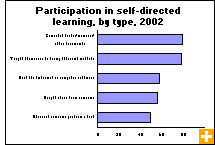Common menu bar links
Many ways to learn
Archived Content
Information identified as archived is provided for reference, research or recordkeeping purposes. It is not subject to the Government of Canada Web Standards and has not been altered or updated since it was archived. Please contact us to request a format other than those available.
After remaining stable during the 1990s, the participation rate of adults in formal training activities has increased substantially throughout Canada. In 2002, 35% of workers aged 25 to 64 had taken formal job-related training, compared with 29% in 1997. However, the average number of hours that participants devoted annually to formal training did not change much: in five years, the average number of hours decreased from 156 to 150.
In 2002, as in the past, young workers and more-educated workers participated the most in formal training. On the other hand, workers aged 55 to 64 registered the largest increase: 23% of them took formal job-related training in 2002, compared with 15% in 1997.
 An employer's support can help overcome many obstacles to training, such
as cost, operational requirements and family responsibilities. The employer's
role in staff training has changed in recent years. In 2002, a larger proportion
of workers undertook training on their own initiative and at their own expense
compared with 1997.
An employer's support can help overcome many obstacles to training, such
as cost, operational requirements and family responsibilities. The employer's
role in staff training has changed in recent years. In 2002, a larger proportion
of workers undertook training on their own initiative and at their own expense
compared with 1997.
Job-related training is not restricted to formal training. By 2002, self-directed learning had become almost as common an option as formal training.
In 2002, even though all types of self-directed learning were popular with participants, nearly 80% said they had consulted documents and had tried different work methods as ways to learn on their own. The proportion of participants who reported using the Internet or computer software was 58%. Those who reported other methods of self-directed learning, such as observing someone performing a task or seeking advice from someone, had participation rates of 49% and 56%, respectively.


